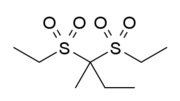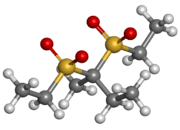Trional
 | |
 | |
| Clinical data | |
|---|---|
| ATC code | none |
| Legal status | |
| Legal status |
|
| Identifiers | |
| |
| CAS Number |
76-20-0 |
| PubChem (CID) | 6433 |
| ChemSpider |
6193 |
| UNII |
217727W28W |
| ECHA InfoCard | 100.000.858 |
| Chemical and physical data | |
| Formula | C8H18O4S2 |
| Molar mass | 242.356 g/mol |
| 3D model (Jmol) | Interactive image |
| |
| |
| | |
Trional (Methylsulfonal) is a sedative-hypnotic[1] and anesthetic drug with GABAergic actions. It has similar effects to sulfonal, except it is faster acting.[2]
History
Trional was prepared and introduced by Eugen Baumann and Alfred Kast in 1888.[3]
Appeared in Agatha Christie's "Murder On The Orient Express", "And Then There Were None" and other novels as a sleep inducing sedative, and in In Search of Lost Time (Sodom and Gomorrah) by Marcel Proust as an hypnotic.
See also
References
- ↑ (1907). Merck's 1907 Index. N. Y.: Merck & Co., p. 448.
- ↑ Sajous, Charles E. (1896). Annual of the Universal Medical Sciences
Philadelphia: F. A. Davis, v. 5, p. A-156. - ↑ Drinkwater, H. (1924). Fifty years of medical progress, 1873-1922.
New York: The Macmillan Company, p. 40.
| Inhalational | |||||||||||||||
|---|---|---|---|---|---|---|---|---|---|---|---|---|---|---|---|
| Injection |
| ||||||||||||||
| |||||||||||||||
| Alcohols | |
|---|---|
| Barbiturates |
|
| Benzodiazepines |
|
| Carbamates | |
| Flavonoids | |
| Imidazoles | |
| Kava constituents |
|
| Monoureides |
|
| Neuroactive steroids |
|
| Nonbenzodiazepines |
|
| Phenols | |
| Piperidinediones | |
| Pyrazolopyridines | |
| Quinazolinones | |
| Volatiles/gases |
|
| Others/unsorted |
|
See also: GABAergics | |
This article is issued from Wikipedia - version of the 8/18/2016. The text is available under the Creative Commons Attribution/Share Alike but additional terms may apply for the media files.